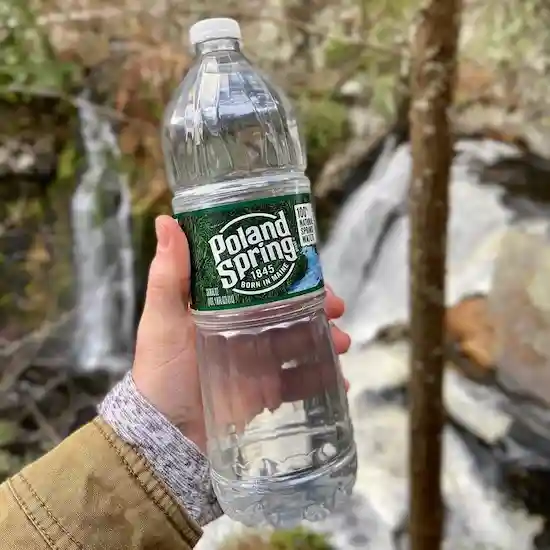Poland Spring water is touted to be completely sourced from natural springs. It is advertised to contain electrolytes and provide a fresh taste. It is named after Poland Springs in Maine, USA.
The ownership of the brand changed hands in 2021 – when One Rock Capital Partners and Metropoulos & Co. acquired it from Nestle Waters. Poland Springs has mixed reviews from consumers and experts. Let us discover if it is good for you.
Table of Contents
What is in Poland Spring water?
Poland Spring water is said to be 100% sourced from natural springs that are rich in minerals and are highly alkaline. So, does the brand demonstrate the same features? Here are the details picked from its water quality report.
| pH | 6.7-7.1 |
| Total Dissolved Solids (TDS) | 27-62 parts per million (ppm) |
Is Poland Spring water really spring water?
Poland Spring water is said to be produced completely from the following natural sprints in the state of Maine.
- Poland Spring – This is the original source for the product but is not in use now. The company has set up a museum here as a memory.
- Garden Spring – Is in close proximity to Poland Spring.
- Evergreen Spring – Its location provides a magnificent view of the western mountains.
- White Cedar Spring – Is a popular travel destination for skiing and snowmobiling.
- Cold Spring – Is located near Pleasant Mountain, surrounded by waterways and thick forests.
- Clear Spring – Is formed from water flowing from primeval glaciers.
- Bradbury Spring – Is situated in the valley formed by Sugarloaf and Mount Abraham.
- Spruce Spring – Is in the vicinity of Bigelow Mountain Range.
- Bella Luna Spring – A new addition to the brand’s list of spring water sources.
Hardness
Hardness is measured by the presence of calcium carbonate. For drinking water, the recommended scale is 60-120 mg/L. Poland Spring water has a hardness of between 15-28 milligrams per liter (mg/L).
The hardness of water does not have a direct correlation with health. However, calcium carbonate is considered a beneficial supplement for a healthy heart, bones, muscles, and nerves. It facilitates acid digestion and heals heartburn.
Alkaline or acidic
The alkalinity of Poland Spring water is 11-21 mg/L, while its pH is 6.7-7.1. The recommended alkalinity for drinking water is 20-200 mg/L. On this scale, the brand scores unsatisfactorily. However, its pH is acceptable – closer to the neutral pH of water at seven.
The US Environmental Protection Agency (EPA) proposes a pH of 6.5-8.5 for drinking water. The pH scores of the brand are within this limit, so is safe for drinking. Conclusively, Poland Spring water is neither acidic nor alkaline – it is neutral.
Purification and distillation
Poland Spring follows a stringent distillation process to purify water. Bottled products from each line are also tested 250 times a year to achieve the intended quality.
The company also takes utmost care to ensure that you get the purest water by constantly supervising water streams, precipitation levels, and areas encircling the springs.
Poland Spring water lawsuit
Poland Spring was named in two lawsuits questioning its integrity during the time it was owned by Nestle Waters.
- In 2003, a lawsuit was filed in Connecticut Superior Court alleging that the company had on many occasions misrepresented the source of its bottled water product. The company claimed that it sourced water from Poland Spring – however, the spring has not been in existence since 1967. The company was accused of deriving its water from groundwater sources and a spring located near a landfill.
Nestle Waters was made to settle the lawsuit through payment of $10 million to charity.
- In 2017, another lawsuit made similar allegations against Poland Spring – it stated that the company did not draw its water from springs or protected waterways. The actual source was said to be ordinary groundwater.
Is Poland Spring water safe?
Poland Spring water does not enjoy a great rep. There have been calls from various organizations to avoid the brand on allegations that it contains contaminants and chemicals. But how much of this is hyperbole, and how much is true? Let us do a check.
Fluoride
The fluoride content in Poland Spring water is undetectable at levels below 0.14 mg/L. The safe levels of the mineral as recommended by the EPA for drinking water is four mg/L.
Fluoride is important for maintaining good oral health, strong teeth, mineralization of tooth enamel, and healthy bones. While it is good for your drinking water to contain fluoride, the absence of it from Poland Spring does not really mean much. There are plenty of other ways to include fluoride in your diet.
Sodium/salt
Poland Spring water contains 1.3-10 mg/L of sodium. This is much lower than EPA’s recommended levels of 30-60 mg/L. However, health experts propose sodium levels in your drinking water to be below 20 mg/L.
Sodium is an essential mineral – it helps in balancing body fluids, maintaining healthy blood pressure levels, and efficient functioning of nerves and muscles. In addition, its composition affects the taste of water.
We draw our sodium requirements mostly from food. Therefore, excessive ingestion of it from water alone may not be safe – especially for those advised to be on a low-sodium diet. Higher sodium levels in the blood raise the risks of heart diseases, high blood pressure, and stroke.
Electrolytes
Electrolytes are essential minerals that are important for many bodily functions. Here’s a look at the composition of electrolytes in Poland Spring water.
| Electrolytes in Poland Spring water | Composition (mg/L) | Recommended Levels (mg/L) |
| Sodium | 1.3-10 | 30-60 |
| Calcium | 4.1-9 | 20-120 |
| Chloride | 0-15 | <250 |
| Magnesium | 1.2-1.7 | 20-30 |
| Sulfate | 1.6-7.7 | <250 |
| Manganese | Not detected | <0.5 |
| Potassium | Not detected | <5 |
Electrolytes are necessary for regulating fluid balance, controlling nerve impulses, cell division, blood clotting, muscle contraction, healthy heart, strong bones, and robust immunity.
The presence of electrolytes in Poland Spring water is a tad low – especially sodium, calcium, chloride, and potassium. These are crucial minerals for us. Although lower levels of sodium are acceptable, calcium and chloride play an important role in electrolyte neutrality, regulation of fluids, and controlling acid levels in the body. A low level of electrolytes in water also influences its taste.
Chlorine
Poland Spring Water does not contain chlorine as the chemical is not used in the purification process. The majority of water treatment processes across the world use chlorine to kill bacteria and viruses. At levels of up to four mg/L, chlorine is considered safe in drinking water. Ingesting higher levels of chlorine will lead to stomach aches, diarrhea, and vomiting. It will also give water a repulsive odor and taste.
Magnesium
There is between 1.2-1.7 mg/L of magnesium in Poland Spring against the recommended levels of 20-30 mg/L for drinking water. Ingestion of magnesium through drinking water enhances digestive health and prevents constipation. The mineral is involved in over 300 enzyme systems that control protein synthesis, blood sugar and blood pressure levels, nerve and muscle functions, heart health, inflammation, depression, and exercise performance.
The daily recommended dietary allowance of magnesium is 400-420 mg for men and 310-320 for women. While you can get a portion of this from food sources, it is important that there is a good contribution from drinking water too.
If you are already experiencing muscle spasms, constipation, vomiting, and fatigue – then, opt for a water source that is rich in magnesium.
Chemicals
Poland Spring’s water quality report does not show the presence of any harmful chemicals. However, there have been several reports of a decline in the product quality and the water containing a metallic taste.
Following a lawsuit alleging that the company procures almost all its water from groundwater sites that are located near landfills, garbage pits, or petroleum dump sites, the New Hampshire Department of Health issued a warning that some water bottles of the brand may be contaminated by gasoline.
Many consumer reports echoed the same. Although only three and five-gallon water bottles were found to be affected, there is pessimism about the safety of the brand in general.
High exposure to gasoline in drinking water can result in stomach aches, diarrhea, vomiting, and nausea. Additionally, Poland Spring water bottles could also leach chemicals and toxins that are harmful to health.
Sugar
Poland Spring water does not contain sugar. It is only a purified spring water product. However, if you want a sweet drink, you can try Poland Sparkling water. It is a carbonated drink available in various flavors. It contains natural fruit flavorings and sucralose.
Additives
Poland Spring does not contain any additives. Several bottled water companies add minerals and salts to water after the purification process. This is because the arduous purification removes essential minerals from water. These additions are made to also improve the taste of water. However, Poland Spring water does not contain any additives.
PFAs
Poland Spring water does not contain PFAs. Perfluoroalkyl (PFA) substances are synthetic chemicals that are classified as human carcinogens. Increased exposure to these chemicals can result in high cholesterol levels, high blood pressure, and liver issues.
Arsenic
The water quality report suggests that Poland Spring water contains arsenic in non-detectable amounts. Arsenic is a toxic heavy metal that can be found in contaminated water. Increased exposure to it can cause digestive problems, cancer, skin lesions, and diminished nerve functioning.
Lead
Poland Spring water contains lead in non-detectable amounts. Lead is usually found in water sources that use pipes and plumbing fixtures. They are rarely found in bottled water products.
Lead is a highly toxic substance that can trigger heart problems, high blood pressure, cardiovascular complications, and kidney issues.
Is Poland Spring water bad?
Poland Spring water is not a great choice for hydration and nutrients. You can drink it to quench your thirst while traveling. But is it bad?
There are several reports questioning the source of the product – there are also allegations that it contains contaminants. While these aspects are being probed, let us find out if the bottles are safe for you.
Poland Spring water is available in these types of plastic bottles.
- Single-serve bottles: containing eight ounces to three liters of water – made from non-recycled PET #1 plastic that is free of BPA
- One-gallon and 2.5-gallon bottles: made from non-recycled high-density polyethylene (HDPE) #2 plastic that is free of BPA
- Five-gallon bottles: made from PET #1 plastic that is free of BPA
- Three-gallon bottles: made from polycarbonate #7 plastic. Contains BPA in less than one part per billion.
The company asserts that its packaging is compliant with FDA standards.
Bisphenol A or BPA – the synthetic organic compound used to make plastics and resins – is found in traces only in three-gallon bottles. However, research has found that even low-level exposure to the harmful chemical increases the risk of high blood pressure, diabetes, cardiovascular diseases, prostate gland issues in fetuses, prostate cancer in adults, and lower sperm count in adults. Frequent exposure can also lead to brain damage.
PET or polyethylene terephthalate plastic is said to be BPA-free. However, a Goethe University research has shown that PET plastic leaches chemicals that affect estrogen and other hormones in the body. Plastic also has other harmful health effects.
Can Poland Spring water make you sick?
Poland Spring is a defendant in lawsuits that allege that its water is not drawn from pure natural springs, as advertised, but instead from ordinary groundwater. These lawsuits further claim that the groundwater sources may be situated near landfills, human waste dumps, and ash piles. The company has been proved guilty in one of the lawsuits.
This surely prods us to put on our thinking hat and wonder if it is safe to drink Poland Spring water. Could it make you sick? Let’s dig deeper.
Diarrhea
There are no reports of Poland Spring triggering any serious cases of diarrhea. However, if you suffer from irritable bowel syndrome or have a poor digestive system, you could run a risk of confronting diarrhea by drinking Poland Spring water.
Poland Spring has almost no potassium content. Using this as your regular source of water could make you deficient in Potassium and this can cause diarrhea in the long run. Other related symptoms like vomiting, muscle cramps, and fatigue could come along.
Additionally, chemical leaching and toxicity can cause diarrhea if you are drinking out of plastic bottles too often. Not just that, when water is stored in plastic bottles for several days, it becomes a suitable ground for the growth of bacteria. Yes – consumption of water from these bottles can lead to diarrhea and vomiting.
Heartburn
Poland Spring water is a pH-neutral source of water, and as such is not acidic. It is hence unlikely to cause heartburn or acidity.
However, if you are already acidic, the product may aggravate the problem because it is low in calcium carbonate and other essential minerals that are known to help control acid reflux.
Cancer
Poland Spring water is free of toxins and heavy metals that pose the danger of causing cancer. There are no known carcinogens in the product either.
The plastic that the Poland Spring bottles are made out of can have harmful health effects, but they are not known to cause cancer.
Is Poland Spring water bad for your teeth?
Probably yes. We say so because Poland Spring contains undetectable levels of fluoride – the mineral is important for strong teeth and mineralization of tooth enamel.
According to Medical News Today, insufficient levels of fluoride in your drinking water will provoke a deficiency of the mineral in your mouth and saliva – this, in turn, will cause your tooth enamel to weaken and cause decay.
If you are using Poland Spring water as your regular source of hydration, remember to provide your teeth with some fluoride supplementation in the form of tablets or toothpaste.
Does Poland Spring water expire?
Poland Spring water packaging displays information stating that the product expires two years after the date of manufacture. It is not safe to drink from an expired bottle. Although there is no expiration for the water itself, if it is stored in plastic for too long you will face dangers from plastic degradation and the growth of bacteria.
Is Poland Spring water better than tap water?
Health experts note that tap water is always better than bottled water. In the table below, we point out the reasons why tap water is better than Poland Spring water.
| Poland Spring Water | Tap Water |
| Its purification process is questionable | Is well purified as per regulatory standards |
| Is not well regulated by authorities | Every drop must comply with regulations |
| Testing is subject to company regulations | Is tested more often according to rules laid down by EPA |
| Contains fewer minerals and electrolytes | Is rich in minerals and electrolytes |
| Contains BPA and other plastic toxins | Do not come in contact with plastics |
| Is expensive for regular use | Is cost-effective |
| Requires extensive effort in sourcing, bottling, storing, and transportation | Minimal efforts required |
| Environmental impact is high | No environmental impact |
Where to buy Poland Spring water?
You can buy your stock of Poland Spring water through the company-owned ReadyRefresh app. Here is a list of popular retailers and whether Poland Spring water is available for purchase here.
| Retailer | Is Poland Spring Available? |
| Costco | No |
| Publix | Yes |
| Walmart | Yes |
| Target | Yes |
| Shoprite | Yes |
| Sam’s Club | Yes |
| Aldi | No |
| CVS | Yes |
| Whole Foods Market | Yes |
ALSO READ: Our safety guides on other brands of bottled water
References:
- https://www.polandspring.com/products/spring-water
- https://www.webmd.com/diet/features/best-sources-drinking-water
- Does Glossier Skincare Have Fragrance? - October 21, 2022
- Is Aveeno Color-Safe? - October 20, 2022
- Is Acure Color-Safe? - October 20, 2022



